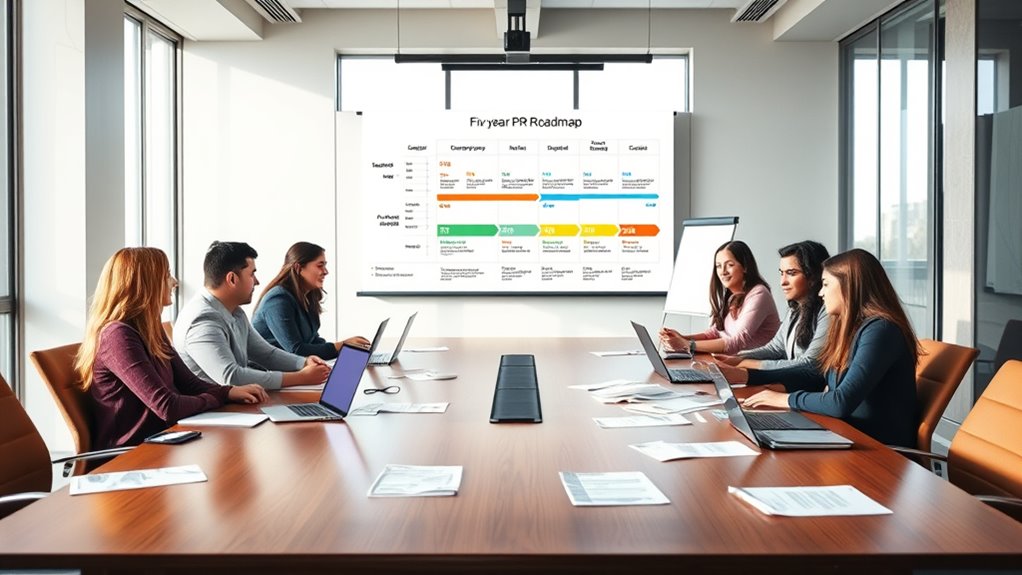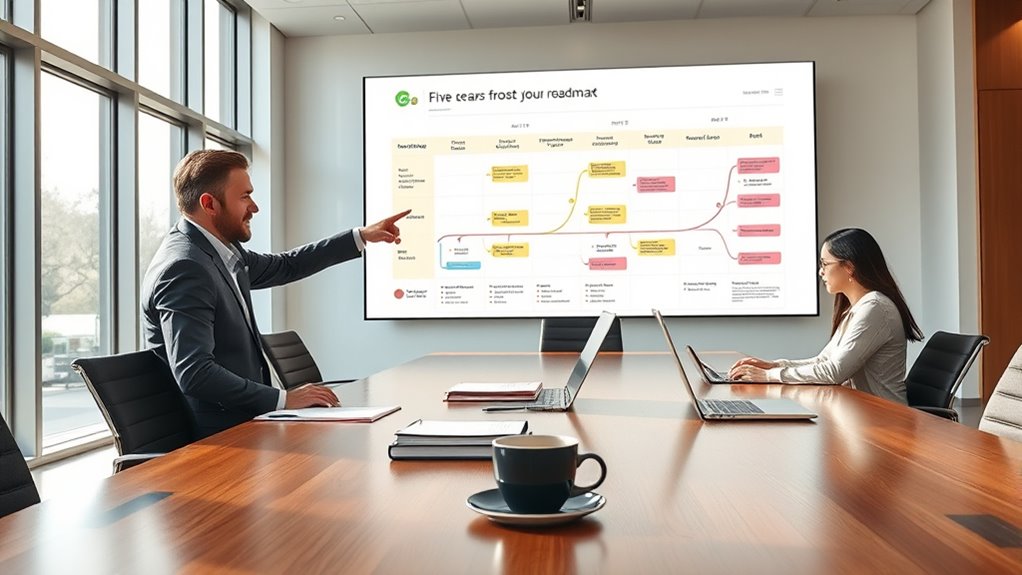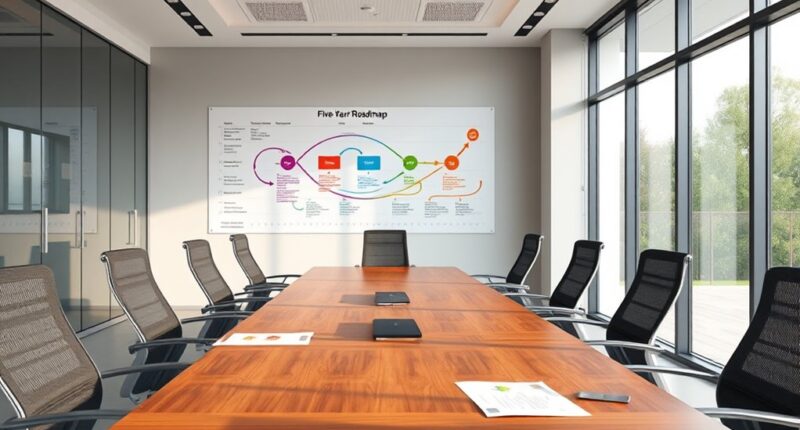To build a five-year PR roadmap, start by setting clear long-term objectives focused on brand credibility and awareness. Next, analyze your current reputation and market position to identify strengths and gaps. Segment your audiences and tailor your messaging accordingly, ensuring consistent storytelling. Develop strategic initiatives, allocate resources wisely, and establish KPIs to measure progress. Regular reviews will help you refine your plan over time. Keep exploring to discover essential steps that will make your PR strategy effective and adaptable.
Key Takeaways
- Define long-term PR objectives aligned with brand vision, audience, and measurable success metrics.
- Conduct thorough reputation and market analysis to identify strengths, vulnerabilities, and strategic opportunities.
- Segment target audiences precisely and develop tailored messaging and engagement strategies.
- Develop tactical initiatives, allocate resources strategically, and establish timelines with milestones for implementation.
- Continuously monitor, review, and refine the roadmap based on media performance, audience feedback, and evolving goals.
Defining Long-Term PR Objectives

To set a strong foundation for your five-year PR roadmap, you need to clearly define your long-term objectives. Focus on how your media outreach efforts will build brand awareness and credibility over time. Consider what messages you want to consistently communicate and the audiences you aim to reach. Your goals should also include strengthening crisis communication strategies, ensuring you’re prepared to handle any reputation challenges that arise. Think about measurable outcomes, like increased media placements or improved public perception. By establishing clear, achievable objectives, you create a roadmap that guides your PR activities, aligns your team, and keeps your efforts focused on sustainable growth. Remember, these goals will shape your strategies and influence every decision along the way. Incorporating essential oils for brand resilience can also help maintain clarity and focus during challenging times. Embracing a mindset that values failure as a learning tool can foster innovation and adaptability within your strategy, especially when navigating unpredictable media landscapes. Additionally, understanding the importance of long-term reputation management ensures your efforts contribute to sustained success. Recognizing the role of market positioning can help you define how you differentiate your brand over the years and adapt to industry changes.
Analyzing Your Current Reputation and Market Position

Have you thoroughly assessed your current reputation and market position? Start by conducting media monitoring to gauge how your brand is perceived publicly. Review recent coverage, social media mentions, and customer feedback to identify trends and sentiment. This helps you understand your strengths and areas needing improvement. Additionally, analyze your market position relative to competitors, looking at share of voice and brand awareness. Consider your past crisis management efforts—how effectively have you responded to negative situations? This evaluation reveals vulnerabilities and highlights opportunities for growth. Incorporating tools like media monitoring can enhance your understanding of public perception. Understanding your tent camping locations and the unique experiences they offer can also provide insights into how your brand aligns with outdoor and adventure audiences. Evaluating your equipment maintenance and performance, such as with airless paint sprayer tips, can inform how your brand manages quality and reliability. Knowing where you stand now allows you to set realistic goals and craft strategies that build on your current reputation, ensuring your PR efforts are targeted and effective over the next five years. Additionally, assessing your brand’s product innovation and ability to adapt to emerging trends can give you a competitive edge in the evolving marketplace.
Identifying and Segmentation of Target Audiences

To effectively reach your goals, you need clear audience segmentation strategies. By examining demographic and psychographic criteria, you can identify the groups most likely to engage with your message. This focused approach guarantees your PR efforts resonate and generate meaningful results. Incorporating positive thinking techniques into your messaging can further enhance your audience engagement and foster a constructive mindset. Understanding core personality traits through tools like the 16PF can also help tailor your communication strategies to better connect with different audience segments.
Audience Segmentation Strategies
Effective audience segmentation is essential for crafting a targeted PR strategy that resonates with your stakeholders. By understanding different segments, you can tailor your messages, making influencer partnerships more impactful and crisis communication more effective. Focus on identifying groups based on their needs, interests, and behaviors, rather than just demographics. This approach helps you allocate resources efficiently and build stronger relationships. When a crisis arises, knowing your audience segments allows you to deliver clear, relevant messages that address their specific concerns. Additionally, engaging influencers within these segments can amplify your reach and credibility. Proper segmentation ensures your PR efforts are precise, timely, and aligned with your overall communication goals, ultimately strengthening your reputation and stakeholder trust over the long term.
Demographic and Psychographic Criteria
Understanding your target audience requires a clear analysis of both demographic and psychographic criteria. Demographic targeting helps you identify basic traits like age, gender, income, and education, providing a foundational profile. Psychographic profiling dives deeper into attitudes, values, interests, and lifestyle, revealing what motivates your audience. To effectively segment your audience, consider these key aspects:
- Age groups and gender differences
- Income levels and educational background
- Values, beliefs, and lifestyle choices
- Interests, hobbies, and media consumption habits
Conducting Competitive and Industry Benchmarking

Conducting competitive and industry benchmarking allows you to see how your organization compares to key players and market standards. Start by analyzing media coverage to identify who’s gaining the most visibility and what messaging resonates. Look at influencer partnerships to see which collaborations drive engagement and credibility. Pay attention to the tone, frequency, and channels used by competitors, and note gaps or opportunities for your own PR efforts. Benchmarking helps you understand industry trends and set realistic goals, ensuring your strategy aligns with or surpasses market expectations. Regularly updating this data keeps you informed about shifts in media attention and influencer activity, giving you a competitive edge in refining your communication tactics over the next five years.
Developing Core Messaging and Brand Narrative

To build a strong PR foundation, you need to clearly define your brand voice and key messages. This helps guarantee your communications resonate consistently across all channels. Crafting effective narrative frameworks ties everything together and guides your storytelling efforts.
Clarify Brand Voice
Clarifying your brand voice is essential for creating consistent and authentic messaging that resonates with your audience. Your brand tone influences how your audience perceives you and helps build trust. To achieve voice consistency, focus on defining key elements like personality, language style, and emotional appeal. Consider these steps:
- Identify adjectives that describe your brand’s personality
- Choose language that matches your audience’s preferences
- Establish guidelines for tone in different contexts
- Train your team to maintain consistency across channels
Define Key Messages
Defining your key messages is essential for creating a clear and compelling brand narrative that guides all your communications. Your core messages should be consistent across press releases and media outreach efforts, ensuring your story remains unified and memorable. Focus on what sets your organization apart, highlighting key benefits and values. These messages will serve as the foundation for your messaging framework, helping you communicate effectively with your target audience. When preparing press releases, use your key messages to craft compelling headlines and supporting points. During media outreach, stay focused on these core messages to build credibility and foster trust. Clear, consistent messaging will strengthen your brand’s voice and improve recognition over the long term.
Craft Narrative Frameworks
Developing a strong narrative framework starts with crafting core messaging that resonates with your target audience and accurately reflects your brand’s identity. To do this effectively, you need to employ storytelling techniques that engage and inspire trust. Focus on message consistency across all channels to build recognition and credibility. Consider these key steps:
- Identify your brand’s unique value proposition
- Use compelling stories that illustrate your core messages
- Tailor messaging to different audience segments without losing consistency
- Guarantee every communication reinforces your overarching narrative
Outlining Key Strategies and Tactical Initiatives

To effectively shape your five-year PR roadmap, you need to identify and prioritize key strategies that align with your overall business goals. Focus on building strong media partnerships to amplify your message and expand reach. Simultaneously, develop a robust crisis management plan to protect your brand’s reputation during unforeseen challenges. These strategies serve as the foundation for tactical initiatives, such as targeted media outreach, influencer collaborations, and proactive communication protocols. Ensure each initiative directly supports your broader objectives, like increasing brand awareness or establishing industry authority. Regularly evaluate and refine these tactics to stay aligned with evolving market conditions. By clearly outlining your key strategies and tactical initiatives, you set a focused path toward measurable PR success over the next five years.
Creating a Timeline and Milestone Schedule

Once you’ve identified your key strategies and tactical initiatives, the next step is to create a clear timeline and milestone schedule to guarantee steady progress. This helps you track your media outreach efforts and prepare for crisis management scenarios. To keep your plan on track, consider these key actions:
- Set specific deadlines for media outreach campaigns and content releases
- Establish milestones for evaluating media engagement and adjusting tactics
- Schedule regular check-ins to review progress and address challenges
- Define emergency response timelines for crisis management to ascertain swift action
Allocating Resources and Budget Planning

Allocating resources and planning your budget are essential steps to guarantee your PR strategy stays on track and delivers results. You need to prioritize spending on key areas like media partnerships and crisis management, ensuring you have enough funds to build strong relationships and handle potential issues. Be strategic about resource distribution, balancing immediate needs with long-term growth. Use this table to guide your planning:
| Area | Budget Allocation | Purpose |
|---|---|---|
| Media Partnerships | 40% | Expand reach and credibility |
| Crisis Management | 20% | Prepare for potential issues |
| Content Creation | 25% | Engage audiences effectively |
| Monitoring & Analytics | 15% | Measure and adjust strategies |
Establishing Metrics and KPIs for Success

Effective metrics and KPIs turn your resource investments into measurable results. To track your PR success, focus on clear indicators like media engagement, audience reach, and message resonance. For crisis communication, measure response times, sentiment analysis, and stakeholder trust levels. Define specific KPIs to evaluate progress:
- Media coverage quantity and quality
- Social media engagement rates
- Response time during crises
- Audience sentiment and perception shifts
These metrics help you stay aligned with your goals, identify areas for improvement, and demonstrate ROI. Regularly reviewing these KPIs ensures your strategy remains effective and adaptable. By establishing concrete benchmarks, you turn abstract efforts into tangible, actionable insights that guide your five-year PR roadmap.
Reviewing and Adjusting the Roadmap Regularly

Regularly reviewing and adjusting your PR roadmap guarantees it stays aligned with evolving goals and external conditions. Establish feedback loops by gathering input from your team, stakeholders, and audience to identify what’s working and what isn’t. Use these insights to inform your adjustment cycles, ensuring your strategies remain relevant and effective. Consistent reviews help catch potential issues early, allowing you to pivot quickly when needed. This proactive approach keeps your PR efforts agile and responsive to change. Make it a habit to evaluate your roadmap periodically—quarterly or biannually—and refine your plans accordingly. By embedding feedback loops into your process, you create a dynamic roadmap that evolves with your organization and the external landscape, maximizing your chances for long-term success.
Frequently Asked Questions
How Can Emerging Trends Influence My Five-Year PR Plan?
Emerging trends can profoundly shape your five-year PR plan by pushing you to adapt quickly and stay relevant. You should incorporate trend adaptation to meet changing audience expectations and leverage innovation strategies to stand out. By staying alert to industry shifts, you can refine your messaging, adopt new channels, and develop creative campaigns that resonate. This proactive approach ensures your PR efforts remain effective and future-proof.
What Risks Should I Anticipate During Long-Term PR Implementation?
Did you know that 70% of companies face reputational risks from crises? Long-term PR plans can be vulnerable to unexpected events, so you should anticipate risks like crisis management failures and negative publicity. Stay prepared by developing clear response strategies and monitoring your reputation continuously. Being proactive helps you mitigate damage, ensuring your long-term efforts stay on course despite unforeseen challenges.
How Do I Align PR Goals With Overall Business Objectives?
To align PR goals with your overall business objectives, focus on maintaining brand consistency and messaging alignment. You should clearly understand your company’s vision and guarantee your PR strategies support it. Regularly communicate with other departments to stay updated on business priorities. Create measurable PR objectives that reflect your core business goals, adjusting campaigns as needed to stay aligned and reinforce your brand’s message across all channels.
What Tools Are Essential for Tracking Long-Term PR Success?
Imagine missing out on key insights that could shape your PR success. That’s why media monitoring and data analytics are essential tools for tracking your long-term PR progress. Media monitoring keeps you alert to coverage and sentiment shifts, while data analytics reveal trends and measure impact over time. Together, they provide the clarity you need to adjust strategies proactively, ensuring your efforts align with business goals and deliver sustained results.
How Can Stakeholder Feedback Shape the PR Roadmap?
Stakeholder engagement is essential for shaping your PR roadmap, as their feedback offers valuable insights into your brand’s perception and priorities. By actively listening and integrating their feedback, you guarantee your strategies align with their expectations and needs. This continuous feedback integration helps you refine messaging, identify opportunities, and build stronger relationships, ultimately leading to more effective and targeted PR efforts over the long term.
Conclusion
By following these steps, you’ll set a solid foundation for your five-year PR roadmap. Stay flexible and adapt as needed—remember, Rome wasn’t built in a day. Keep your eyes on your long-term goals, measure your progress, and don’t be afraid to make adjustments along the way. With persistence and a clear plan, you’ll be well on your way to building a reputation that stands the test of time.









